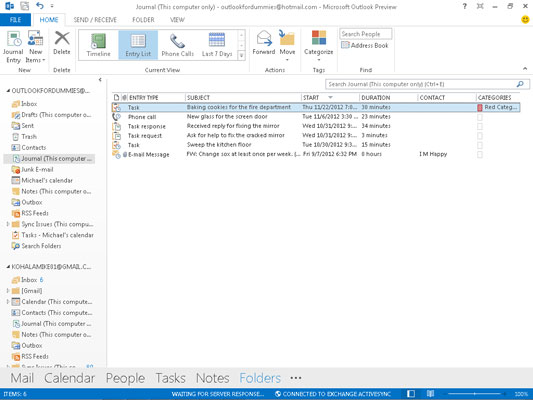As with other Outlook 2013 modules, the Journal comes with multiple views that show your entries in different ways — whether that’s a record of phone calls or a list organized by the names of the people you’ve dealt with.
The Current View choices in the Ribbon let you change quickly from one view to the next.
The Journal can be helpful whether you choose to use it regularly or rarely. You don’t have to limit yourself to recording documents or Outlook items. You can keep track of conversations or customer inquiries or any other transaction in which chronology matters. You can also play starship captain and record everything you do.
Timeline view for the Outlook Journal
Timeline view is an arrangement that shows a strange little chronologically ordered diagram of all your Journal entries to show which entries you created first and which you created last. If you keep track of the time you spend on things like phone calls, longer calls take up more space than shorter ones. Clicking the Timeline button in the Ribbon does no harm, but it does very little good, either.
Entry List view for the Outlook Journal
The Entry List view shows the whole tomato — it’s a view that lists all your Journal entries, regardless of whom, what, or when. To see the Entry List view, click the Entry List button in the Ribbon’s Current View section.

You can click the heading at the top of any column to sort the list according to the information in that column. If you want to arrange your list of Journal entries by the type of entry, for example, click the Entry Type header. Your list is sorted alphabetically by type of entry, with conversations before e-mail, e-mail before faxes, and so on.
The Outlook Journal's Phone Calls view
Because you can keep track of your phone calls in the Journal, the Journal lists the calls you’ve tracked. Simply click the Phone Calls button in the Ribbon. To print a list of your phone calls, switch to Phone Calls view and press Ctrl+P.
The Outlook Journal's Last 7 Days view
The items you’re likely to need first are the ones you used last. That’s why Last 7 Days view offers a quick way to see your most recent activities. To see a week’s worth of Journal entries, click the Last 7 Days button in the Ribbon’s Current View section.
Documents you’ve created, phone calls, e-mail messages — anything you’ve done on your computer in the last seven days — is in Last 7 Days view. This view shows anything you’ve worked on during the last week — including documents that you may have originally created a long time ago. That’s why you may see some pretty old dates in this view.





